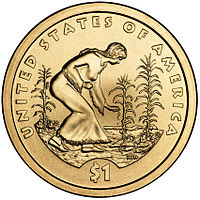Three Sisters (Agriculture)
The Three Sisters is an agricultural method in which the three main crops of the Indians , pumpkin , corn and beans (mostly tepary beans or kidney beans ) are grown together. The method was especially widespread among the Iroquois who traded in the products.
Course of events

As a mixed culture , the plants are planted close to one another. Flat piles of earth are piled up for each group of plants. Each pile of earth is around 30 cm high and 50 cm wide. In parts of the Atlantic Northeast , rotten fish are buried in the mound to fertilize nutrient-poor soil. Several corn seeds are placed in the middle. As soon as the corn has reached a height of 15 cm, beans and pumpkins are placed alternately around the corn. The method took approximately 5,000 to 6,000 years to develop. The pumpkin was cultivated first, followed by the corn and finally the beans.
The three fruits benefit from each other. The corn acts as a climbing pole for the beans. The beans bring nitrogen into the soil, which is used by the other plants. The pumpkin spreads on the ground and covers weeds. The pumpkin leaves act in a manner similar to mulch , they create a microclimate that maintains the moisture in the soil, the hairs of the shoots keep pests away. Corn does not contain the amino acids lysine and tryptophan , which the human body needs to make proteins and niacin . Beans contain both amino acids and therefore make a balanced diet when combined with corn.
Different Indian cultures have developed different variations of the method. The milpas in Central America are fields or gardens that employ symbiotic plant forms on a larger scale. The Anasazi adapted the method for thorn bush savannahs . The Tewa and other tribes in the southwestern United States planted Cleome serrulata as a fourth plant , which attracted bees and other pollinating insects.
The method is depicted on the reverse of a Sacagawea dollar coin issued in 2009 .
photos
See also
Individual evidence
- ^ The science behind the Three Sisters mound system: An agronomic assessment of an indigenous agricultural system in the northeast. In: Jane Mt. Pleasant, John E. Staller, Robert H. Tykot and Bruce F. Benz: Histories of Maize: Multidisciplinary approaches to the prehistory, linguistics, biogeography, domestication , and evolution of maize. ISBN 978-1-5987-4496-5 Academic Press, Amsterdam: 2006, Chapter 38, pp. 529-537
- ↑ John Vivian: The Three Sisters . Mother Earth News . February – March 2001. Retrieved September 18, 2013.
- ^ A b Amanda J. Landon: The "How" of the Three Sisters: The Origins of Agriculture in Mesoamerica and the Human Niche . In: University of Nebraska-Lincoln (Ed.): Nebraska Anthropologist . , Lincoln, NE2008, pp. 110-124.
- ^ A b G. HS Bushnell: The Beginning and Growth of Agriculture in Mexico . In: Royal Society of London (ed.): Philosophical Transactions of the Royal Society of London . 275, No. 936, London, 1976, pp. 117-120. doi : 10.1098 / rstb.1976.0074 .
- ^ Gilbert Wilson: Agriculture of the Hidatsa Indians: An Indian Interpretation . Dodo Press, Gloucestershire 1917, ISBN 978-1409942337 , p. 25.
- ^ Charles Mann: 1491: New Revelations of the Americas Before Columbus . Vintage Books, New York 2005, ISBN 978-1-4000-3205-1 , pp. 220-221.
- ↑ Toby Hemenway: Gaia's Garden: A Guide to Home-Scale Permaculture . Chelsea Green Publishing, White River Junction, VT 2000, ISBN 1-890132-52-7 , p. 149.
- ↑ 2009 Native American $ 1 coin . United States Mint. Retrieved September 18, 2013.
Web links
- Companion Planting-Three Sisters, Old Farmer's Almanac
- Virtual Museum of Canada, The St. Lawrence Iroquoians - Virtual exhibition on agriculture of the Iroquois



